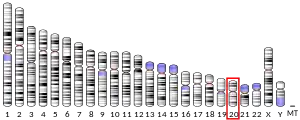CPNE1
Copine-1 is a protein that in humans is encoded by the CPNE1 gene.[5][6]
Calcium-dependent membrane-binding proteins may regulate molecular events at the interface of the cell membrane and cytoplasm. This gene encodes a calcium-dependent protein that also contains two N-terminal type II C2 domains and an integrin A domain-like sequence in the C-terminus. However, the encoded protein does not contain a predicted signal sequence or transmembrane domains. This protein has a broad tissue distribution and it may function in membrane trafficking. This gene and the gene for RNA binding motif protein 12 overlap at map location 20q11.21. Sequence analysis identified multiple alternatively spliced variants in the 5' UTR. All variants encode the same protein.[6]
References
- GRCh38: Ensembl release 89: ENSG00000214078 - Ensembl, May 2017
- GRCm38: Ensembl release 89: ENSMUSG00000074643 - Ensembl, May 2017
- "Human PubMed Reference:". National Center for Biotechnology Information, U.S. National Library of Medicine.
- "Mouse PubMed Reference:". National Center for Biotechnology Information, U.S. National Library of Medicine.
- Creutz CE, Tomsig JL, Snyder SL, Gautier MC, Skouri F, Beisson J, Cohen J (Feb 1998). "The copines, a novel class of C2 domain-containing, calcium-dependent, phospholipid-binding proteins conserved from Paramecium to humans". J Biol Chem. 273 (3): 1393–402. doi:10.1074/jbc.273.3.1393. PMID 9430674.
- "Entrez Gene: CPNE1 copine I".
External links
- Human CPN1 genome location and CPN1 gene details page in the UCSC Genome Browser.
- Human CPNE1 genome location and CPNE1 gene details page in the UCSC Genome Browser.
Further reading
- Savino M, d'Apolito M, Centra M, et al. (1999). "Characterization of copine VII, a new member of the copine family, and its exclusion as a candidate in sporadic breast cancers with loss of heterozygosity at 16q24.3". Genomics. 61 (2): 219–26. doi:10.1006/geno.1999.5958. PMID 10534407.
- Deloukas P, Matthews LH, Ashurst J, et al. (2002). "The DNA sequence and comparative analysis of human chromosome 20". Nature. 414 (6866): 865–71. Bibcode:2001Natur.414..865D. doi:10.1038/414865a. PMID 11780052.
- Strausberg RL, Feingold EA, Grouse LH, et al. (2003). "Generation and initial analysis of more than 15,000 full-length human and mouse cDNA sequences". Proc. Natl. Acad. Sci. U.S.A. 99 (26): 16899–903. Bibcode:2002PNAS...9916899M. doi:10.1073/pnas.242603899. PMC 139241. PMID 12477932.
- Tomsig JL, Snyder SL, Creutz CE (2003). "Identification of targets for calcium signaling through the copine family of proteins. Characterization of a coiled-coil copine-binding motif". J. Biol. Chem. 278 (12): 10048–54. doi:10.1074/jbc.M212632200. PMID 12522145.
- Cowland JB, Carter D, Bjerregaard MD, et al. (2003). "Tissue expression of copines and isolation of copines I and III from the cytosol of human neutrophils". J. Leukoc. Biol. 74 (3): 379–88. doi:10.1189/jlb.0203083. PMID 12949241. S2CID 1754733.
- Tomsig JL, Sohma H, Creutz CE (2004). "Calcium-dependent regulation of tumour necrosis factor-alpha receptor signalling by copine". Biochem. J. 378 (Pt 3): 1089–94. doi:10.1042/BJ20031654. PMC 1224034. PMID 14674885.
- Gerhard DS, Wagner L, Feingold EA, et al. (2004). "The status, quality, and expansion of the NIH full-length cDNA project: the Mammalian Gene Collection (MGC)". Genome Res. 14 (10B): 2121–7. doi:10.1101/gr.2596504. PMC 528928. PMID 15489334.
- Rual JF, Venkatesan K, Hao T, et al. (2005). "Towards a proteome-scale map of the human protein-protein interaction network". Nature. 437 (7062): 1173–8. Bibcode:2005Natur.437.1173R. doi:10.1038/nature04209. PMID 16189514. S2CID 4427026.
- Ma J, Dempsey AA, Stamatiou D, et al. (2007). "Identifying leukocyte gene expression patterns associated with plasma lipid levels in human subjects". Atherosclerosis. 191 (1): 63–72. doi:10.1016/j.atherosclerosis.2006.05.032. PMID 16806233.



